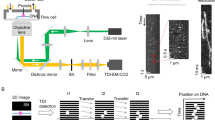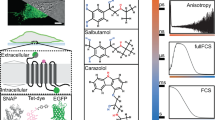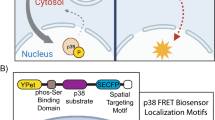Abstract
Here we report the use of fluorescence recovery after photobleaching (FRAP) to examine the intranuclear dynamics of fluorescent oestrogen receptor-α (ER). After bleaching, unliganded ER exhibits high mobility (recovery t1/2 < 1 s). Agonist (oestradiol; E2) or partial antagonist (4-hydroxytamoxifen) slows ER recovery (t1/2 ∼5–6 s), whereas the pure antagonist (ICI 182,780) and, surprisingly, proteasome inhibitors each immobilize ER to the nuclear matrix. Dual FRAP experiments show that fluorescent ER and SRC-1 exhibit similar dynamics only in the presence of E2. In contrast to reports that several nuclear proteins show uniform dynamics, ER exhibits differential mobility depending upon several factors that are linked to its transcription function.
This is a preview of subscription content, access via your institution
Access options
Subscribe to this journal
Receive 12 print issues and online access
$209.00 per year
only $17.42 per issue
Buy this article
- Purchase on Springer Link
- Instant access to full article PDF
Prices may be subject to local taxes which are calculated during checkout






Similar content being viewed by others
References
Tsai, M. J. & O'Malley, B. W. Molecular mechanisms of action of steroid/thyroid receptor superfamily members. Annu. Rev. Biochem. 63, 451–486 (1994).
Mangelsdorf, D. J. et al. The nuclear receptor superfamily: the second decade. Cell 83, 835–839 (1995).
Beato, M., Chavez, S. & Truss M. Transcriptional regulation by steroid hormones. Steroids 61, 240–251 (1996).
Htun, H., Holth, L. T., Walker, D., Davie, J. R. & Hager, G. L. Direct visualization of the human estrogen receptor alpha reveals a role for ligand in the nuclear distribution of the receptor. Mol. Biol. Cell 10, 471–486 (1999).
Stenoien, D. L. et al. Subnuclear trafficking of estrogen receptor-α and steroid receptor coactivator-1. Mol. Endocrinol. 14, 518–534 (2000).
Cook, P. R. The organization of replication and transcription. Science 284, 1790–1795 (1999).
Onate, S. A., Tsai, S. Y., Tsai, M. J. & O'Malley, B. W. Sequence and characterization of a coactivator for the steroid hormone receptor superfamily. Science 270, 1354–1357 (1995).
Jenster, G. et al. Steroid receptor induction of gene transcription: a two-step model. Proc. Natl Acad. Sci. USA 94, 7879–7884 (1997).
McKenna, N. J., Lanz, R. B. & O'Malley, B. W. Nuclear receptor coregulators: cellular and molecular biology. Endocr. Rev. 20, 321–344 (1999).
Heery, D. M., Kalkhoven, E., Hoare, S. & Parker, M. G. A signature motif in transcriptional co-activators mediates binding to nuclear receptors. Nature 387, 733–736 (1997).
Mak, H. Y., Hoare, S., Henttu, P. M. & Parker, M. G. Molecular determinants of the estrogen receptor-coactivator interface. Mol. Cell. Biol. 19, 3895–3903 (1999).
Brzozowski, A. M. et al. Molecular basis of agonism and antagonism in the oestrogen receptor. Nature 389, 753–758 (1997).
Feng, W. et al. Hormone-dependent coactivator binding to a hydrophobic cleft on nuclear receptors. Science 280, 1747–1749 (1998).
Shiau, A. K. et al. The structural basis of estrogen receptor/coactivator recognition and the antagonism of this interaction by tamoxifen. Cell 95, 927–937 (1998).
Nawaz, Z. et al. The Angelman syndrome-associated protein, E6-AP, is a coactivator for the nuclear hormone receptor superfamily. Mol. Cell. Biol. 19, 1182–1189 (1999).
Lee, J. W., Ryan, F., Swaffield, J. C., Johnston, S. A. & Moore, D. D. Interaction of thyroid-hormone receptor with a conserved transcriptional mediator. Nature 374, 91–94 (1995).
Rubin, D. M. et al. Identification of the gal4 suppressor Sug1 as a subunit of the yeast 26S proteasome. Nature 379, 655–657 (1996).
Jensen, E. V., Suzuki, T., Numata, M., Smith, S. & DeSombre, E. R. Estrogen binding substances of target tissues. Steroids 13, 417–427 (1969).
Eckert, R. L., Mullick, A., Rorke, E. A., & Katzenellenbogan, B. S. Estrogen receptor synthesis and turnover in MCF-7 breast cancer cells measured by a density shift technique. Endocrinol. 114, 629–637 (1984).
Scholl, S. & Lippman, M. E. The estrogen receptor in MCF-7 cells: evidence from dense amino acid labeling for rapid turnover and a dimeric model of activated nuclear receptor. Endocrinol. 115, 1295–1301 (1984).
Nawaz, Z., Lonard, D. M., Dennis, A. P., Smith, C. L. & O'Malley, B. W. Proteasome-dependent degradation of the human estrogen receptor. Proc. Natl Acad. Sci. USA 96, 1858–1862 (1999).
El Khissiin, A. & Leclercq, G. Implication of proteasome in estrogen receptor degradation. FEBS Lett. 448, 160–166 (1999).
Alarid, E. T., Bakopoulos, N. & Solodin, N. Proteasome-mediated proteolysis of estrogen receptor: a novel component in autologous down-regulation. Mol. Endocrinol. 13, 1522–1534 (1999).
Lonard, D. M., Nawaz, Z., Smith, C. L. & O'Malley, B. W. The 26S proteasome is required for estrogen receptor-α and coactivator turnover and for efficient estrogen receptor-α transactivation. Mol. Cell 5, 939–948 (2000).
McNally, J. G., Muller, W. G., Walker, D., Wolford, R. & Hager, G. L. The glucocorticoid receptor: rapid exchange with regulatory sites in living cells. Science 287, 1262–1265 (2000).
Phair, R. D. & Misteli, T. High mobility of proteins in the mammalian cell nucleus. Nature 404, 604–609 (2000).
Kruhlak, M. J. et al. Reduced mobility of the alternate splicing factor (ASF) through the nucleoplasm and steady state speckle compartments. J. Cell Biol. 150, 41–51 (2000).
Ellenberg, J. & Lippincott-Schwartz, J. Dynamics and mobility of nuclear envelope proteins in interphase and mitotic cells revealed by green fluorescent protein chimeras. Methods 19, 362–372 (1999).
Horwitz, K. B. & McGuire, W. L. Actinomycin D prevents nuclear processing of estrogen receptor. J. Biol. Chem. 253, 6319–6322 (1978).
Borras, M. et al. Estradiol-induced down-regulation of estrogen receptor. Effect of various modulators of protein synthesis and expression. J. Steroid. Biochem. Mol. Biol. 48, 325–336 (1994).
Nickerson, J. A., Krockmalnic, G., Wan, K. M. & Penman, S. The nuclear matrix revealed by eluting chromatin from a cross-linked nucleus. Proc. Natl Acad. Sci. USA 94, 4446–4450 (1997).
De Conto, F. et al. In mouse myoblasts nuclear prosomes are associated with the nuclear matrix and accumulate preferentially in the perinucleolar areas. J. Cell Sci. 113, 2399–2407 (2000).
Tokumoto, M., Yamaguchi, A., Nagahama, Y. & Tokumoto, T. Identification of the goldfish 20S proteasome β6 subunit bound to nuclear matrix. FEBS Lett. 472, 62–66 (2000).
Fawell, S. E., Lees, J. A., White, R. & Parker, M. G. Characterization and colocalization of steroid binding and dimerization activities in the mouse estrogen receptor. Cell 60, 953–962 (1990).
Smith, C. L., Nawaz, Z. & O'Malley, B. W. Coactivator and corepressor regulation of the agonist/antagonist activity of the mixed antiestrogen, 4-hydroxytamoxifen. Mol. Endocrinol. 11, 657–666 (1997).
Grese, T. A. et al. Molecular determinants of tissue selectivity in estrogen receptor modulators. Proc. Natl Acad. Sci. USA 94, 14105–14110 (1997).
Dauvois, S., White, R. & Parker, M. G. The antiestrogen ICI 182780 disrupts estrogen receptor nucleocytoplasmic shuttling. J. Cell. Sci. 106, 1377–1378 (1993).
Devin-Leclerc, J. et al. Interaction and dissociation of estrogen receptor and Hsp90: the antiestrogen RU 58668 induces a protein synthesis dependent clustering of the receptor in the cytoplasm. Mol. Endocrinol. 12, 842–854 (1998).
Pederson, T. Diffusional protein transport within the nucleus: a message in the medium. Nature Cell Biol. 2, E73–E74 (2000).
Lewis, J. D. & Tollervey, D. Like attracts like: getting RNA processing together in the nucleus. Science 288, 1385–1389 (2000).
Shopland, S. L. & Lawrence, J. B. Seeking common ground in nuclear complexity. J. Cell Biol. 150, F1–F4 (2000).
McKenna, N. J., Nawaz, Z., Tsai, S. Y., Tsai, M. J. & O'Malley, B. W. Distinct steady-state nuclear receptor coregulator complexes exist in vivo. Proc. Natl Acad. Sci. USA 95, 11697–11702 (1998).
Seksek, O., Biwersi, J. & Verkman, A. S. Translational diffusion of macromolecule-sized solutes in cytoplasm and nucleus. J. Cell Biol. 138, 131–142 (1997).
Robinett, C. C. et al. In vivo localization of DNA sequences and visualization of large-scale chromatin organization using lac operator/repressor recognition. J. Cell Biol. 135, 1685–1700 (1996).
Tang, Y. & DeFranco, D. B. ATP-dependent release of glucocorticoid receptors from the nuclear matrix. Mol. Cell. Biol. 16, 1989–2001 (1996).
Hu, L. M., Bodwell, J., Hu, J. M., Orti, E. & Munck, A. Glucocorticoid receptors in ATP-depleted cell. Dephosphorylation, loss of hormone binding, HSP90 dissociation, and ATP-dependent cycling. J. Biol. Chem. 269, 6571–6577 (1994).
Stenoien, D. L. et al. Polyglutamine-expanded androgen receptors form aggregates that sequester heat shock proteins, proteasome components and SRC-1, and are suppressed by the HDJ-2 chaperone. Hum. Mol. Genet. 8, 731–741 (1999).
Acknowledgements
We thank J. Nickerson, A. Belmont, Z. D. Sharp and D. DeFranco for critical reviews of the manuscript, E. Schwoebel and M. S. Moore for assistance with ATP-depletion experiments, and A. Cooney and Z. Nawaz for discussions. This work was supported by NIH grant RO1 DK55622 and a National American Heart Association Scientist Development Award (9630033N) to M.A.M., an NIH postdoctoral fellowship (1F32DK09787) to D.L.S., NIH grant RO1 DK53002 to C.L.S., and funding from the Department of Molecular and Cellular Biology, Baylor College of Medicine, Houston, Texas.
Author information
Authors and Affiliations
Corresponding author
Rights and permissions
About this article
Cite this article
Stenoien, D., Patel, K., Mancini, M. et al. FRAP reveals that mobility of oestrogen receptor-α is ligand- and proteasome-dependent. Nat Cell Biol 3, 15–23 (2001). https://doi.org/10.1038/35050515
Received:
Revised:
Accepted:
Published:
Issue Date:
DOI: https://doi.org/10.1038/35050515
This article is cited by
-
Molecular dynamics of estrogen-related receptors and their regulatory proteins: roles in transcriptional control for endocrine and metabolic signaling
Anatomical Science International (2022)
-
Subcellular dynamics of estrogen-related receptors involved in transrepression through interactions with scaffold attachment factor B1
Histochemistry and Cell Biology (2021)
-
Navigating the crowd: visualizing coordination between genome dynamics, structure, and transcription
Genome Biology (2020)
-
Role of SUMOylation in differential ERα transcriptional repression by tamoxifen and fulvestrant in breast cancer cells
Oncogene (2019)
-
Abiraterone shows alternate activity in models of endocrine resistant and sensitive disease
British Journal of Cancer (2018)



